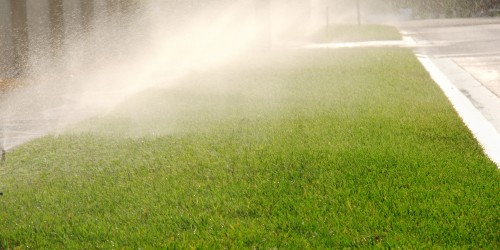If you live in Texas, there’s a good chance you know what the term “xeriscaping” means, or you’ve at least heard the term. Xeriscaping (pronounced “zeer-is-cape-ing”) is an alternative form of landscaping that uses creative design to conserve water. In simpler terms, it’s a landscape that needs less water.
Xeriscaping is one of those landscaping concepts that tends to be a win-win for both the property owner and the landscape. Xeriscaped properties require not only less water, but less maintenance, less fertilizer and less pest control than traditional landscaping styles. All in all, xeriscapes help your wallet and the environment at the same time!
Xeriscaping is not zeroscaping
A lot of folks I talk to have heard the term “zeroscaping” thrown around, and they confuse it with xeriscaping. But there is a major difference between them. Zeroscaping involves designing and building a landscape that uses absolutely no water at all. Xeriscaping, on the other hand, doesn’t eliminate water from the landscape — rather, it’s more about conserving water.
The eight principles of Xeriscaping
Wondering if you can implement xeriscaping in your property’s landscape? You can! There are seven main principles to xeriscaping (we’ve added an eighth for good measure). I like to approach them like steps. Going through these systematically will result in water savings!
- Planning and design — Knowing what areas in your landscape are used for, and how often people will be in different areas, is key. Figure out where the sun hits different parts of your landscape, where the most shade is, where the slopes are and how everything is drained. If you’re unsure, you can always ask us to perform a site assessment. Our staff are experts in xeriscape design!
- Soil improvement — Good soil is one of the most overlooked items in a landscape. Good soil absorbs and holds moisture much better, which encourages plants to grow deep roots. With deep roots, plants can access water even when the topsoil is dry. At Maven, we recommend getting your soil amended with local soil blends, which are made with compost and organic matter. When this is tilled in with your current soil, you’ll be able to use less water.
- Practical turf area — Having lawns that stretch from property line to property line can sure look nice, but they aren’t practical. Consider minimizing your turf areas to spots that have a specific use — like a play area. Try to keep the grass in the most heavily shaded areas. Use water-conserving turf grasses like centipede, zoysia or Bermuda. Mow high, too, because when you do your grass will be able to withstand droughts and bounce back when they’re over.
- Efficient irrigation — Having an efficient, up-to-date irrigation system installed can make a massive difference in water use. If your system isn’t automatic, and you need to water manually, remember this: water less, but water deeply when you do water.
- Mulch — Mulch is like sunblock for plant roots. Two to four inches of mulch can radically affect the amount of moisture in the soil by slowing evaporation and protect it from overheating. Mulch also reduces and often completely eliminates certain weeds that compete with your plants for moisture, nutrients and sun.
- Low water-use plants — This one might seem pretty obvious, but drought-resistance and water conservation aren’t always considerations people have when designing their landscapes. Native plants that are adapted for the area tend to be best — check out the separate post we’ve written on the best plants for dry areas.
- Appropriate maintenance — There are a whole lot of tips and tricks for proper maintenance of a xeriscape. Rather than post them all here, we wrote another post on them!
- Variety — There’s a misconception out there: people either see xeriscapes as desolate, desert-like landscapes or, at the very least, see them as “seas of rock” that are unattractive to look at. But this couldn’t be further from the truth! Xeriscapes can be vibrant and full of variety. In the xeriscapes we’ve designed at Maven, we’ve included decorative boulders as well as various types of colorful mulches, gravel, pebbles and even crushed glass! Many xeriscapes also include small ornamental trees for shade.
So there you have it — a quick rundown of xeriscaping. I hope you found it helpful. Since our establishment in 2006, Maven has designed and installed many landscapes that save our customers both water and money. Our xeriscaping experts are happy to help! Feel free to give us a call if you’d like to find out more.



